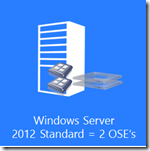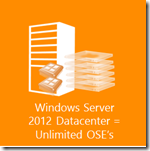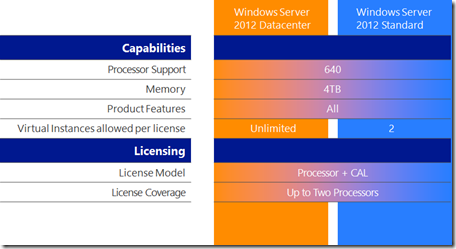Windows Server 2012 Licensing – Part 1
I thought I take some time and demystify some of the licensing changes as well as edition changes that happened with the recent release of Windows Server 2012.
We made the licensing simpler. We consolidated our offering to just four editions;
- Windows Server 2012 Foundation
- Windows Server 2012 Essentials
- Windows Server 2012 Standard
- Windows Server 2012 Datacenter
I will focus mostly on Standard and Datacenter editions in today’s entry.
With the release of Windows Server 2012, Microsoft moved to a consistent licensing model and have common features enabled in both editions. Similar to the System Center 2012 licensing, Windows Server 2012 is now licensed per processor. One single license covers up to two physical processors.
1 x Windows Server 2012 Standard license = will cover 2 physical processors and will give you the right to run 2 virtual machines at no additional cost on that server host.
1 x Windows Server 2012 Datacenter license = will cover 2 physical processors and will give you the right to run unlimited virtual machines at no additional cost on that server host. Client Access Licenses (CALs) will continue to be required for access to Windows Server 2012 servers.
There are no differences between the features of these two editions, they are only differentiated by virtualisation rights ( 2 OSE’s * for Standard; unlimited OSE’s * for Datacenter) . * OSE = Operating System Environment.
With only two editions and with no feature differences, how do you determine which Windows Server 2012 edition is the right edition for you? As discussed, your decision will be based solely on your virtualisation strategy as virtualisation rights become the only differentiator between editions.
If your strategy calls for a highly virtualised environment, the Windows Server 2012 Datacenter edition will provide you with optimum flexibility since it allows for unlimited virtualisation.
If you do not plan on a highly virtualised environment at this time, the Windows Server 2012 Standard edition is the right product for your needs.
If you purchase Standard edition today but find that you need more capacity in the future you will have two options to expand the virtualisation capacity of your licensed server:
1. Purchase additional Standard edition licenses and assign them to the same physical server giving you the rights to run additional instances of Windows Server.
2. If you have Software Assurance on your Standard license you can purchase a Software Assurance Step-Up and migrate to a Datacenter edition license on that server.
If you are running a highly virtualised environment, then management may also be a need for you. You should consider purchasing System Center 2012 with Windows Server 2012 together in the Core Infrastructure Suite, which is available inside or outside of an Enrollment for Core Infrastructure (ECI).
For further information look at Windows Server 2012 how to buy


